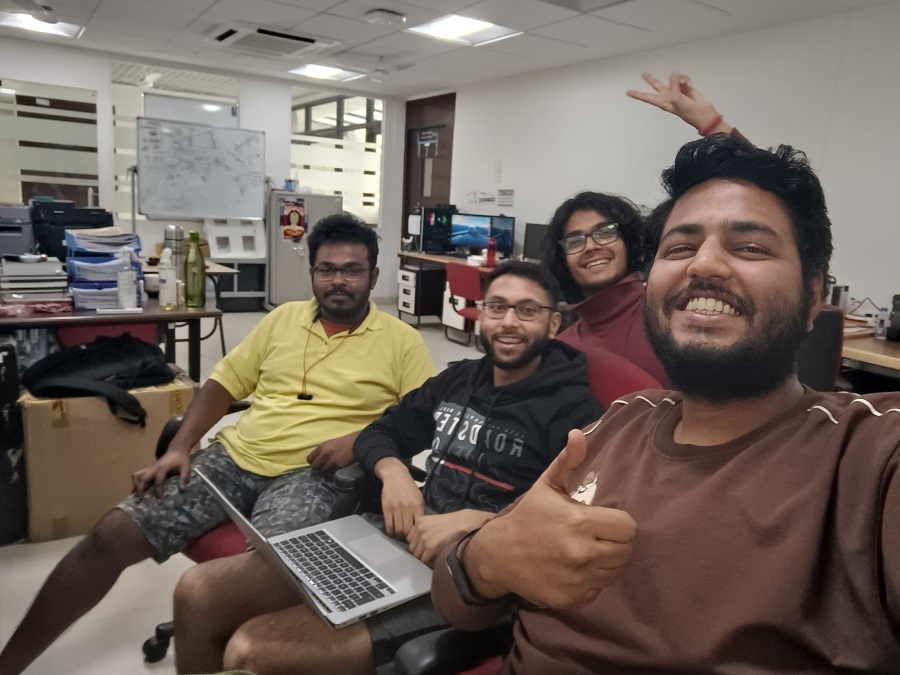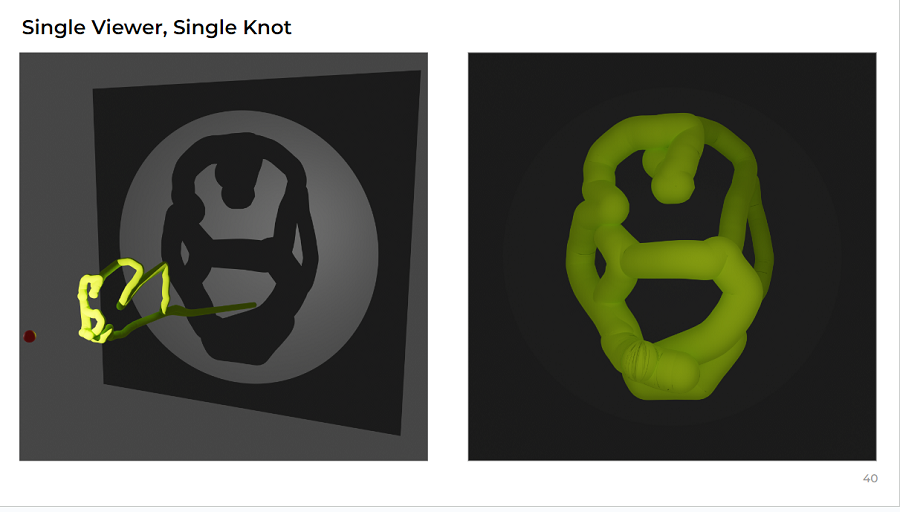STORY CREDITS
Writer: Saumya Mishra
Photo: IITGN Photos
Many of us have attempted to create abstract shapes with our hands to cast shadows on a wall which resemble a bird or an aeroplane. Now, when you look at the hand, the abstract shape of the fingers contorted in a jumbled fashion does not appear meaningful, but the cast shadow forms a recognisable shape. This intriguing and magical world of creating 2D shadows using 3D shapes is called shadow art.
A team of researchers from IIT Gandhinagar has explored the same concept in their recent work and taken it a step further. In their research, they have focussed on creating 3D structures using a technique called differentiable rendering, which is used in computer graphics. As part of the research, the IITGN team focussed on finding 3D knot-based tubular structures which resemble particular target images when viewed from a specific viewpoint.
Their research was inspired by the artwork of Larry Kagan- the American sculptor who uses steel wires, a wall, and a light source to create stunning works of shadow art. At first glance, his artwork appears to be a mess of wires, but when light shines on the installations, the resulting shadows take intricate shapes, such as Che Guevara or a man dribbling a basketball.
The novelty of the IITGN teams’ research lies in their aim to create physically realisable models using differentiable rendering. This makes it suitable for real-world applications. For instance, their work can be used to create and install 3D art sculptures in an art gallery. This research has potential applications in art installations, making it possible to create intricate shadow art for galleries and public spaces.
The research team at IIT Gandhinagar consisted of Aalok Gangopadhyay (Former PhD Scholar), Paras Gupta (Former BTech Student), Tarun Sharma (Former BTech Student), Prajwal Singh (PhD Scholar), and Prof Shanmuganathan Raman. This research has also been published in the Eurographics Journal – Computer Graphics Forum, which ranks among the top 3 journals in Computer Graphics. Additionally, the researchers had the opportunity to present their work at the Symposium on Geometry Processing (SGP) at the Massachusetts Institute of Technology (MIT), USA, in June 2024, which Tarun Sharma attended.
Knots
The IITGN team has considered a specific form of structure called knots for their research. A knot is a closed loop in three-dimensional space that has identical initial and final points. For instance, a circle is the simplest form of a knot with little complexity. Furthermore, moving a sphere along a knot creates a tubular structure. The researchers have used this specific form of structure, tubular knots, in their research.
Additionally, imagine if we have a target image in mind, then arranging the tubular knot to resemble the target image when viewed from a specific viewpoint was the objective of this research.
The study of knots is also used in various other fields, such as mathematics, biology, and chemistry. In mathematics, knot theory is used to help understand three-dimensional spaces and the properties of knots and links. Additionally, knot theory helps us understand the complex structures of DNA, their molecules, and linkages in biology.

Proposed Approach
In their research, the IITGN team introduced the problem as follows. Let’s say we are given a knot that we cannot cut and paste or pass through. The knot can only be stretched, bent, rotated, and translated but cannot self-intersect. This concept is called applying homeomorphism on the knot, wherein a knot can be smoothly and continuously transformed. Researchers use several homeomorphisms or transformations on the initial knot to obtain different knot configurations and ultimately attain the desired image when the tubular knot is viewed from a specific viewpoint.
Apart from the task of matching the target image with the projected image, how can it be determined if this research is practically feasible in the real world? To ensure this, the team has used several parameters or constraints on the knot structure. For instance, in the real world, there may be location constraints. If the artwork is intended for display in an art gallery, then it must fit within a specific area. To satisfy this condition, the researchers have defined an occupancy region constraint, indicating that the knot should lie within a particular region and should not extend beyond it.
Further, they have also kept budget constraints in mind while designing the problem. If the knot is made up of a particular material, the longer the length, the greater the cost. Thus, to manage the expenses, the length of the knot was restricted based on the material’s cost. Moreover, physical materials also have bending limits. So, a bending constraint was also considered. Finally, the self-intersection constraint was also applied to prevent the knot from passing through itself.
The researchers used an invertible neural network to obtain the desired target image using a knot. A neural network is a type of computer system inspired by how the human brain functions. They are used in Artificial Intelligence (AI) to help computers learn from data and make predictions. It proves helpful when the computer finds an error between the targeted and the projected image and goes back and provides feedback on the transformation, telling it how it should change to match the targeted image. Based on this feedback, the system modifies itself slowly to move closer to the targeted image. This is termed the optimisation process.
To showcase the applicability of their work, the researchers also created a real-world demonstration. For this, they 3D printed the tubular structure generated through differentiable rendering for a particular desired image (smiley). Then, they cast a shadow on the wall and showed it through a specific viewpoint to reveal the target image.

Applications in Art and Design
According to the researchers, some practical applications of this research can be found in the artistic domain. Artists might use these insights to create unique art installations. For example, a small miniature sculpture in an art gallery could be designed to cast intricate and meaningful shadows when illuminated. This work can also be used to explore innovative storytelling methods and make learning more creative at various levels of education. On a broader scale, an artist could construct a massive structure that aligns to reveal a specific image or form when viewed from a particular point. These applications show how differential rendering can be used for artistic expression, which can be further enhanced by manipulating light, shadows, and perspective. This will offer the viewers an engaging and dynamic visual experience.

